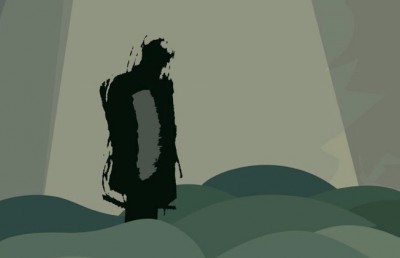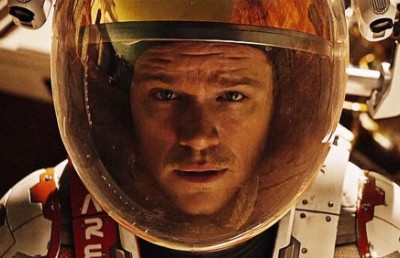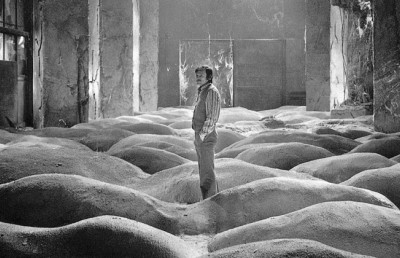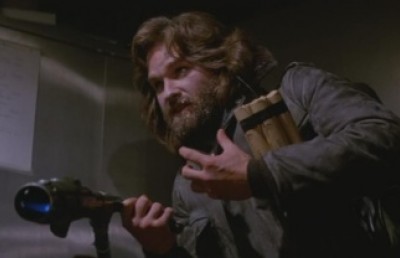Engineering Shock: Part 1 of a Study of the Use of the Startle Effect in The Thing
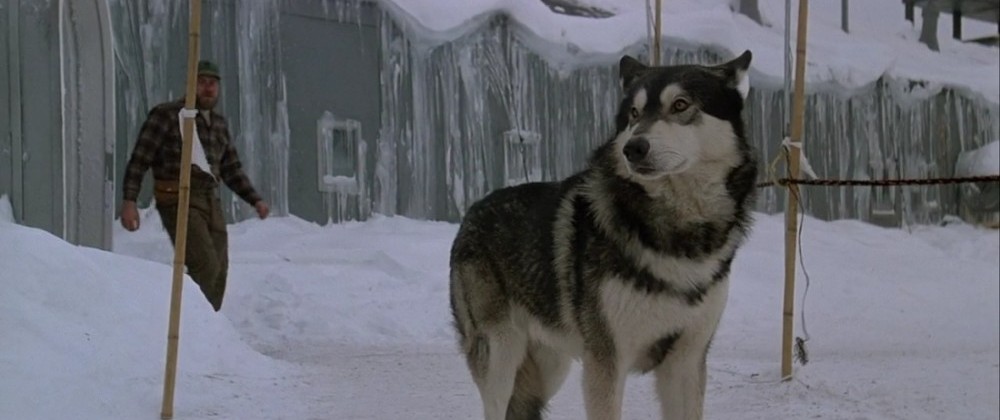
In his recent study “The Startle Effect: Implications for Spectator Cognition and Media Theory,” Robert Baird analyzes the use of startles (also commonly known as jump scares) in the horror genre. Based on his sampling of 100 American horror films, he discusses how both the quantity and formal effectiveness of startles has increased significantly since Val Lewton’s infamous bus first screeched onto the scene to shock audiences in the 1942 film Cat People (13). 1 In spite of their popular use and appeal, Baird discusses how there is a strong tendency among critics to label startles as “the ultimate form of sensationalism, artlessness, and mindlessness” (22). He further notes how even some horror directors share this lack of respect for startles. Specifically, he mentions several instances in the commentary track for Halloween (1978), where director John Carpenter pokes fun at his own use of them (23). This carries over to the commentary for The Thing (1982), where Carpenter often refers to them as “cheap horror movie scares” (Carpenter and Russell). Analyzing these startles closely, however, I contend that Carpenter underemphasizes the thought he puts into them, particularly with respect to The Thing. Accordingly, using two examples from The Thing, I will try to show that startles can be handled with great care. For contrast, one of the startles will be simple and routine (or, as Carpenter calls it on commentary track, “cheap”), while the other one is far more complex. Analyzing and comparing the two, I hope to show how these supposedly “mindless” scares can be invested with artistry.
Example #1 – Startling FuchsThe Plot
It is over an hour into the film; a bleak mood has been well established. The Thing has already killed one of the crewmates living at the Antarctic research station, and has presumably replicated others. The characters are scared and begin distrusting each other. This startle functions as an outgrowth of that paranoid atmosphere. More specifically, the following scene is the last time we see the team’s assistant biologist Fuchs alive.
Shots 1-3: Foreshadowing
(1) The scene starts with a split diopter shot of Fuchs looking over his notes in the foreground off to the right. In the background to the left we see a door, through which MacReady enters.
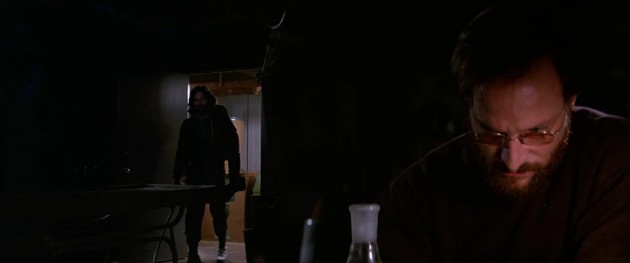
(2) Fuchs, startled by the noise of approaching footsteps, quickly turns. As he does, we match on action to a medium close-up. The cut is punctuated by a quick camera jerk at the start of this second shot. On a purely pragmatic level, this quick movement keeps Fuchs properly framed as he turns. Yet this small bit of “dynamic articulation,” as Noël Burch would call it, also serves to reinforce the anxiety and paranoia the film has been setting up. 2 Moreover, it foreshadows the real startle to come.
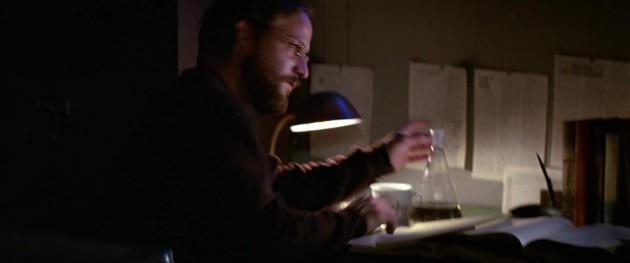
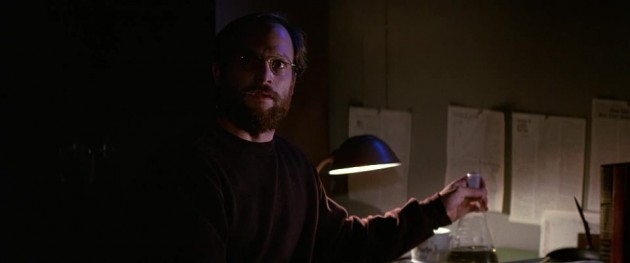
(3) As the two talk, we return to the earlier framing (Shot 1). This framing is further evocative of the growing distrust between the characters, as we see Fuchs and MacReady divided by the hard graphic line of the door. They are even further divided in space as Fuchs occupies the immediate foreground, whereas MacReady is not only relegated to the background, but is framed behind the pool table as well. Once the conversation ends, MacReady exits the scene.
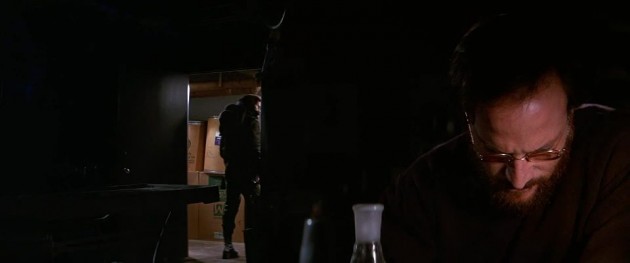
Shots 4-5: The Lights Go Out
(4) We return to the angle from Shot 2 as Fuchs turns back to his research. (5) A close-up of the lamp. The light in the room mysteriously dims while Ennio Morricone’s unsettling, droning score slowly amplifies over the scene. The shot pans across the desk to see Fuchs’ hand opening a drawer and grabbing a flare for light.
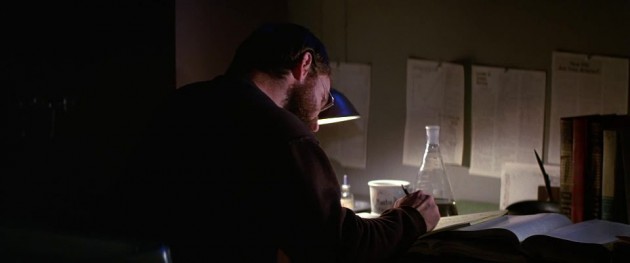
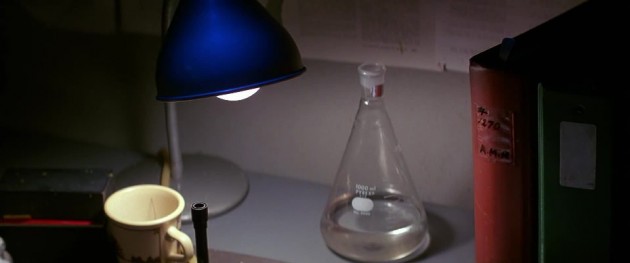
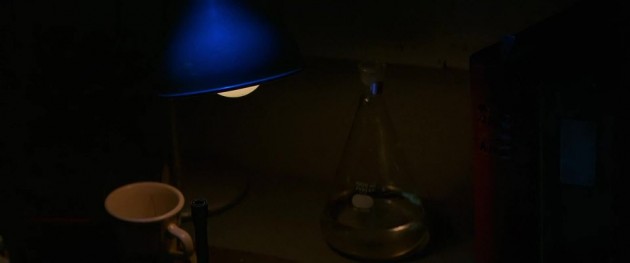
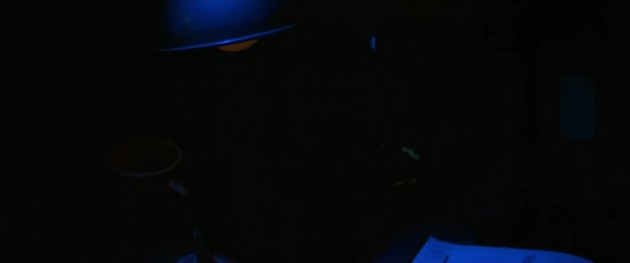
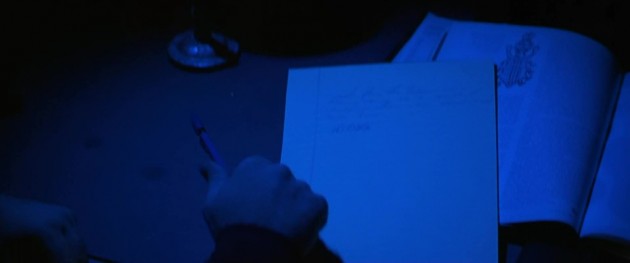
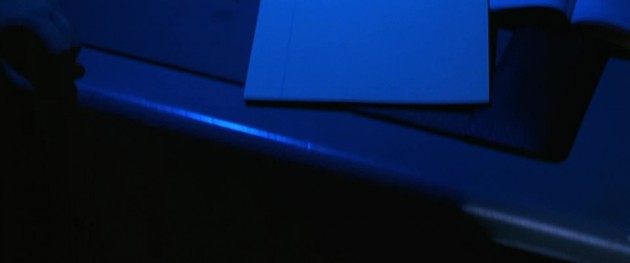
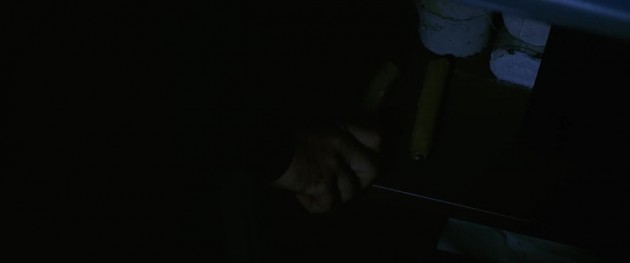
Shot 6: The Startle
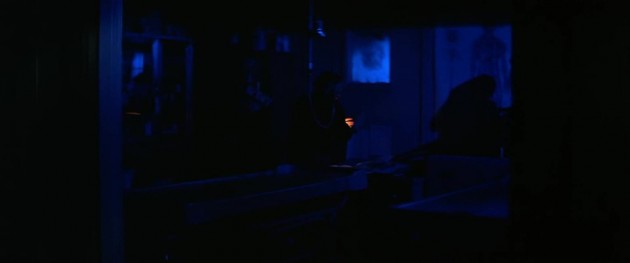
(6) We cut to a long shot of Fuchs framed from behind the doorway seen in earlier shots. The setting is covered in an ominous blue lighting with the only deviation being the dim orange light coming from the flare. The lighting, music, and the earlier foreboding encounter with MacReady create a sense of danger. The camera slowly tracks, keeping him centered as he walks closer, making his way to the doorway. The music slowly fades as he moves closer to the camera. Right before reaching the door, we hear his foot hit what sounds like a can. He looks off to the left of the frame to see what it was, and in doing so, cues us to look in that direction as well. As we look to the left, Carpenter has a silhouetted figure suddenly intrude into the frame from the right. Accompanied by a sudden loud alien shriek, the dark presence momentarily covers the shot before exiting through the left side of the frame. Fuchs is not killed (yet), but he is startled.
The scene actually continues for 3 more shots. In them we see Fuchs follow the shadow outside. He loses the figure, but finds a tattered jacket in the snow with MacReady’s name on it, suggesting that MacReady had been replicated. Given this, perhaps Fuchs was right to jump when MacReady snuck up on him early in the scene.
Analysis of First StartleThis type of startle is very common in horror films and demonstrates many of the ideas Baird discusses in his paper. Most notably, he isolates three core elements which he claims startles must have in order to be effective. The first condition is that there be “a character presence” (15). Ideally, it is a character viewers care about and can identify with (16). In the scene in question, Fuchs is this character, as we likely understand his nervousness while we simultaneously fear for his safety. The second core element is that there be an “implied off-screen threat” (15). While this off-screen threat may be established through exposition, there are nevertheless cues which are frequently used to heighten the sense of danger for particular scenes. Here, for instance, there is the sudden power failure, which implies that the Thing is somewhere nearby tampering with the electrical system. This sense of growing danger leads to the final core element, which is the inevitable “disturbing intrusion into the character’s immediate space” (15). Baird is careful to note that this disturbing intrusion need not necessarily be the established threat, as false alarms are still startling (24). It is difficult to determine whether the scene above should be classified as a false alarm or not, given the monster is responsible for the startle, but it does not actually attack the character until much later. Whatever the case though, the shocking entry of the Thing into the frame still strongly reflects the final core element put forward by Baird.
Also important to note is that the scene exhibits other common techniques associated with startles, some of which Baird briefly touches on in his analysis, but which he doesn’t include as part of this core. I’m speaking specifically of dim lighting, long takes, the lowering of sound, and a brief bit of misdirection before the startle. By having Fuchs lit with a small patch of bright orange light in a scene dominated by dull blue light, Carpenter is able to direct our eyes where he wants them. Moreover, the absence of cuts means that we will not be distracted by constantly having to reorient ourselves in such a dark space. The long take also contributes to the slow pace of the scene, which gradually builds suspense and allows the quick intrusion of the off-screen threat to have more impact. The lowering of sound meanwhile works to make our ears more sensitive and consequently, as Baird notes, more vulnerable to sudden loud noises (20). Finally, the misdirection – Fuchs knocking something with his foot – works to momentarily distract our attention, allowing the startle to catch us off guard.
Given the general effectiveness of these techniques, many of them are present when horror films try to startle us. 3 Unfortunately, because this pattern of techniques eventually becomes recognizable, it can sometimes warn us that we are going to be shocked, potentially making these moments less startling. With this in mind, I will move onto the second scene, as it features a startle which works, in part, because it avoids this pattern.
Example #2 – The Death of ‘Doc’ CopperThe Plot
The rest of the crew find MacReady’s torn jacket and naturally begin to suspect he is infected. MacReady, not wanting to go down without a fight, brandishes a flamethrower and a pack of dynamite, threatening to blow up the base should anyone try to attack him. Overwhelmed by this turn of events, Norris, a member of their crew who was earlier shown to have some sort of heart condition, clutches his chest and collapses.
Shots 1-4: Setting Up the Two Actions
In the opening shots, Carpenter establishes the two actions that will be taking place in this scene.
(1) In the first shot we see MacReady in the center of the frame, clutching his flamethrower and dynamite, trapped by characters on either side of him. The scene gives the impression of a standoff one might see in a western.
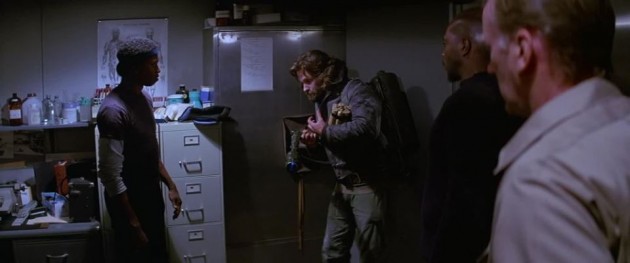
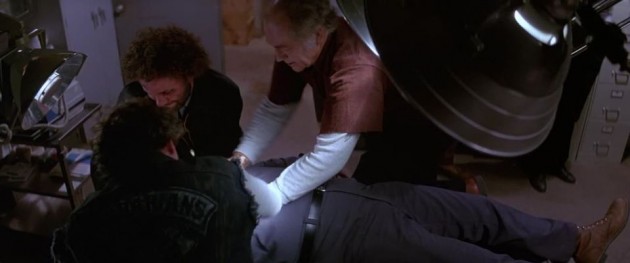
(2) We soon cut to Dr. Copper, Windows, and Palmer, only feet from the other action, as they lay Norris’ body on a table. (3-4) We get two more shots of this action as the doctor attempts to resuscitate Norris with CPR, the urgency suggested by each shot being framed closer than the last.
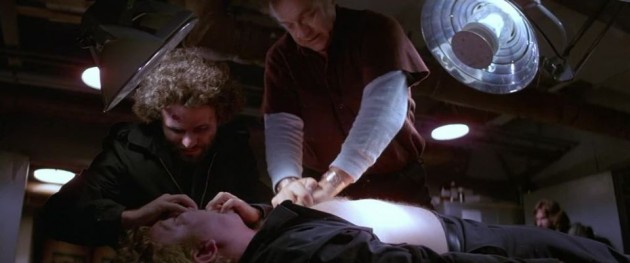
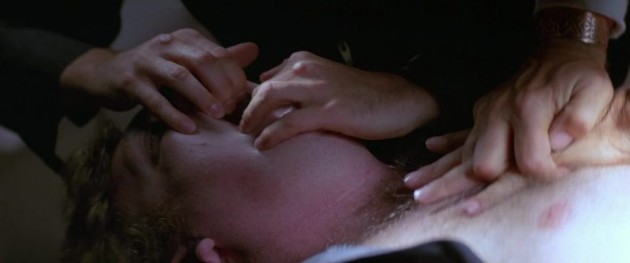
Shots 5-9: Hinting Violence
(5) Back to the standoff, we get a medium close-up of MacReady. He is now framed completely alone as he desperately points the flamethrower at his crewmates. (6) The next shot further creates the impression of a showdown by recreating the famous hip-side low angle shots used in Sergio Leone’s westerns. Clark, slightly out of focus in the background of the shot, seems to look at something. (7) We cut to his POV and see a tray of medical tools. Put in his position, we naturally assume that he is planning to attack MacReady with one of them. This is the point where Carpenter effectively begins to misdirect our attention.
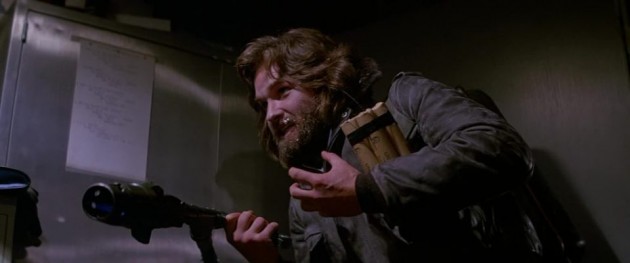
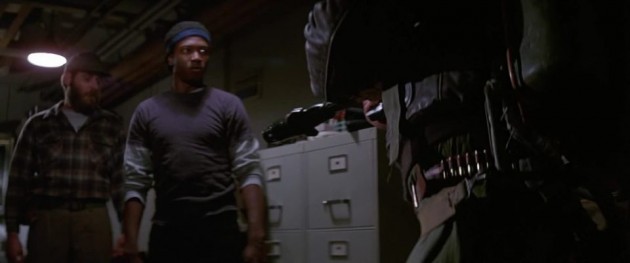
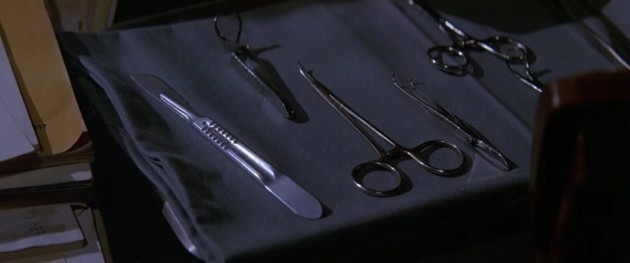
(8) We cut back to the earlier hip-side shot showing Clark and Nauls cornering MacReady from one side and (9) follow it with a shot of Childs, Gary, and Palmer cornering him from the other. We get the impression that it probably won’t end well for MacReady.
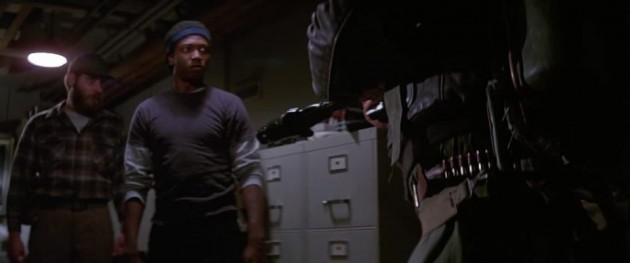
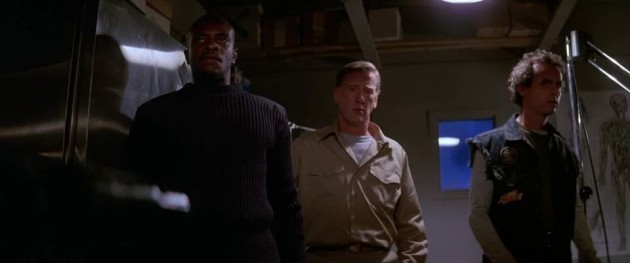
Shots 10-13: The Standoff Intensifies
(10) Copper continues trying to resuscitate Norris, but it isn’t working. (11) Cut to a higher angle as Windows arrives with defibrillators. Unlike earlier, the shots now move farther away from the action, subtly implying that this is becoming less urgent (or at least less interesting) than the standoff.
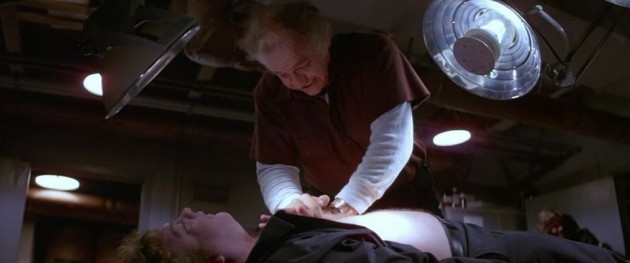
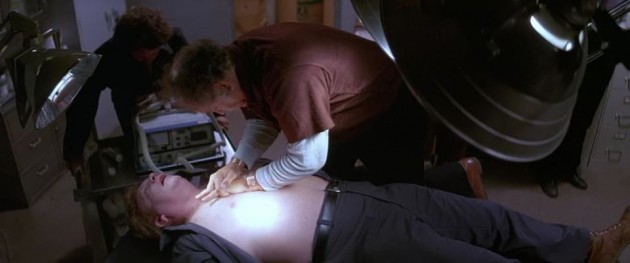
Indeed, contrasting with these shots, when we cut back to the standoff, we get two back-to-back close-ups. (12) The first is of Clark’s hand reaching for a weapon which implies that there will almost surely be violence. (13) Following this we see MacReady in the closest shot of him thus far; one which suggests both his heightened psychological isolation from the rest of the crew and the tension of the situation.
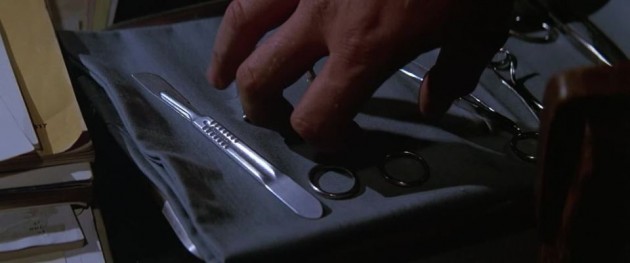
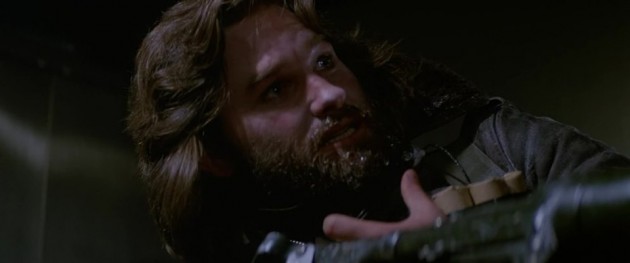
Shots 14-17: Approaching the Breaking Point
(14) The next shot further stresses the sense of hostility and claustrophobia as MacReady is shown in the center again, this time graphically pinned between Clark on the extreme left and Childs on the extreme right. In addition to this, thanks to a split field diopter, on the left in the immediate foreground we clearly see Clark’s hand slowly move into frame holding a scalpel. (15) We cut back to the hip-side angle. Our eyes are on Clark. He appears roughly as he did in shots 6 and 8; however we know that he is now hiding a weapon. More importantly, because he doesn’t look significantly different from this perspective, we can infer that MacReady is unaware of the weapon.
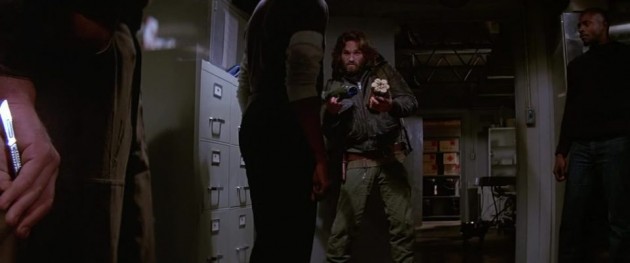
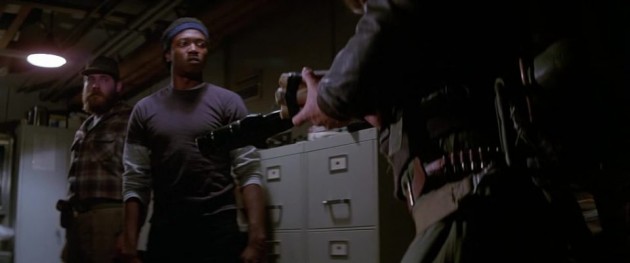
(16) Briefly we return to Copper as he uses the defibrillator to no avail. It is interesting to consider how Carpenter and the film’s editor Todd Ramsay guide our thoughts through the number of shots they present. Introducing this action we had three consecutive shots of Copper attempting to resuscitate Norris. When we returned a second time, there were two. Now there is only one. We get the impression that the film itself believes Norris is a lost cause and that nothing will come of the doctor’s actions.
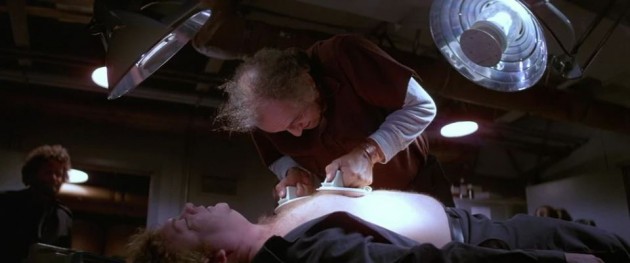
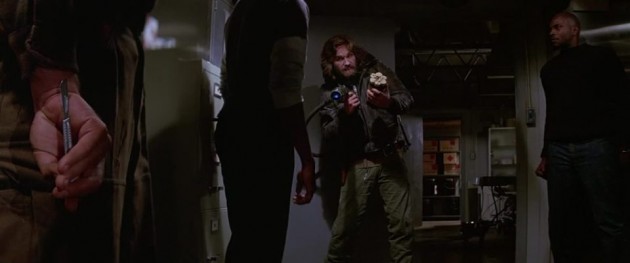
(17) We return to the standoff. It is the same split diopter shot from shot 14, only now the scalpel has made its way fully into the frame. We sense Clark is about to make his move.
Shots 18-20: The Startle
(18) We abruptly cut back to Copper who wants to try the defibrillators again. There is little reason to suspect anything will come of it. Certainly the film has not given us a reason to think such things. (19) As he lowers the paddles, we cut to a high angle shot of Norris’ body and, to our surprise, we see his chest suddenly split open in the fashion of a mouth. Amplifying this shock is a high pitched screech emanating from this inhuman thing. (20) Copper’s hands plunge into Norris’ chest, and we quickly cut to a closer shot of the Thing’s jagged teeth closing in on his arms. It turns out Norris was the threat all along.
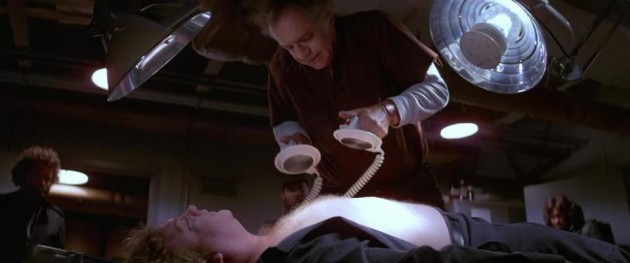
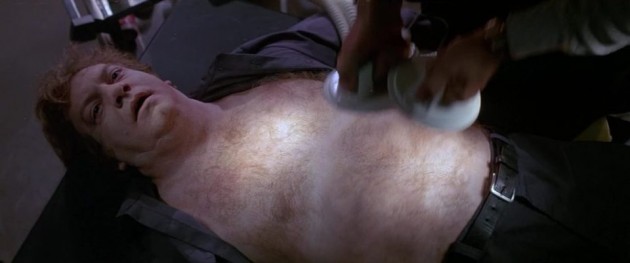
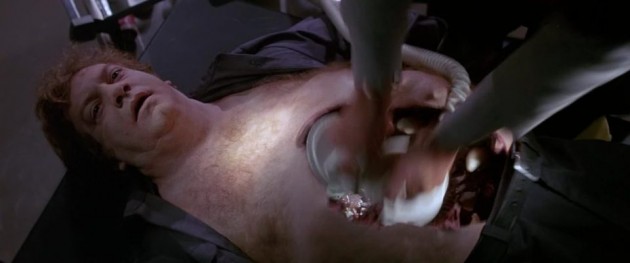
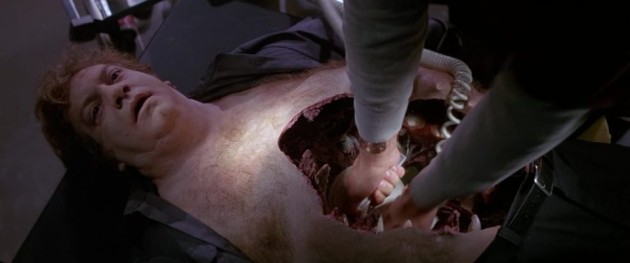
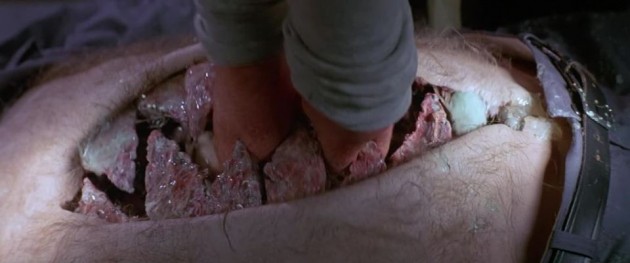
The startle can be seen as twofold. There is the initial surprise of learning that Norris was infected, followed by a second, much more visceral shock of the teeth biting into Copper’s arms.
Shots 21-24: Drawing It Out
(21-24) This second shock is furthered when, in a quick montage, we cut between shots of Copper screaming in pain and the monster chewing off his wrists. The incredibly graphic content of the latter shots mixed with the fast cutting help to sustain the startle for several seconds.
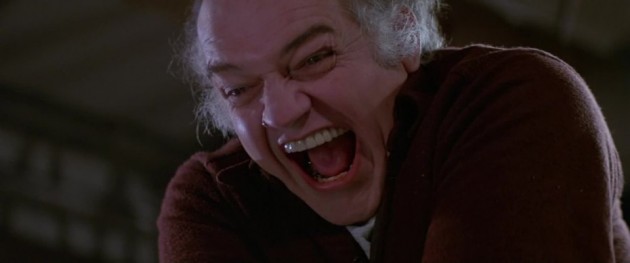
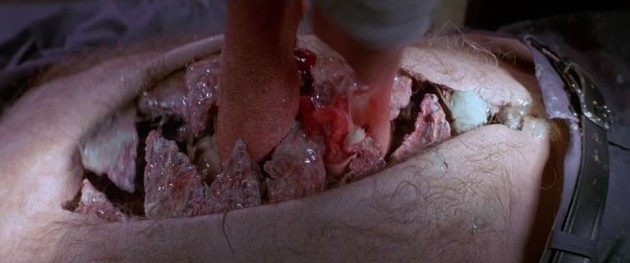
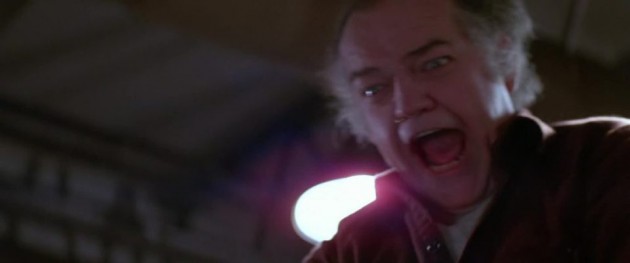

Shots 25-27: A Stunned Crew
(25) As the creature opens its mouth, we cut to a wide shot and see the once bickering crew, gazing in a stunned silence at the shrieking, now handless, doctor. (26) We briefly return to a close-up of Copper as he falls backwards and (27) end on a shot of MacReady who watches the doctor collapse. Like most of us, he is momentarily dumbstruck.
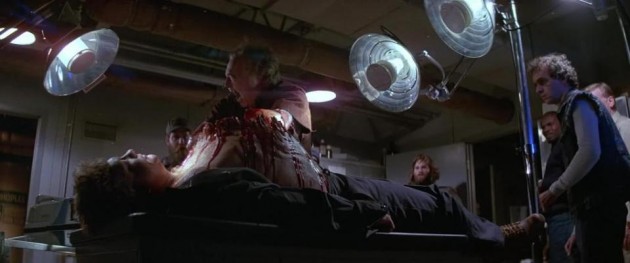
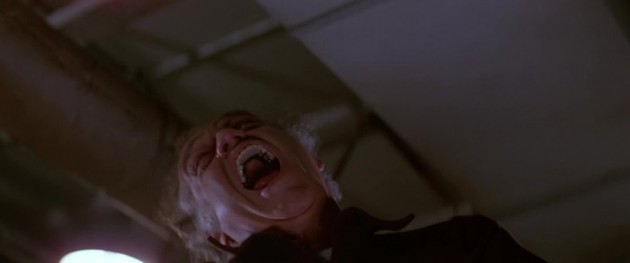
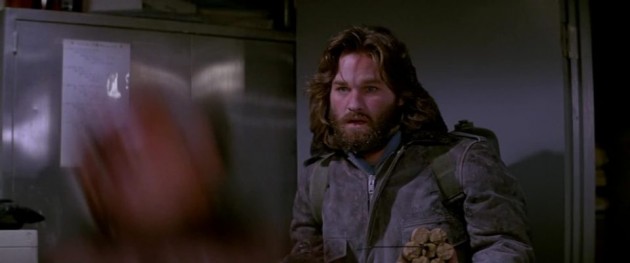
A key aspect of this startle is Carpenter’s ability to juggle two thematically opposed actions and resolve them in an unexpected fashion. On one side of the room we expect to see several characters lose their lives in a desperate struggle. On the other, a doctor is strenuously trying to save another man’s life. In an ironic and startling twist, it turns out that the latter action was the perilous one.
Beyond this, there are some important differences between this startle and the first that deserve to be addressed. Most obviously would be this scene’s use of editing over the long take. Given the complexity of the special effects, this is partly to be expected (unless one thinks it reasonable that Richard Dysart would sacrifice his limbs for this film). Yet the shock created by the speed of the cuts nevertheless functions to heighten the moment and add emphasis. We can also see how the overall editing in the early part of this scene is used to subtly guide our attention away from the actual threat, presenting the standoff as more imperative to our attention until the Thing finally reveals itself. Another major formal difference would be the total lack of music. Unlike the first scene, in which the slow musical fade might act as a signal to the experienced horror watcher that there is a startle around the corner, the lack of musical cues makes this surprise much harder to foresee.
What is further interesting is that this scene actually subverts two of Baird’s “core elements.” Here, the only actively implied threat comes from Clark (or MacReady, depending on whom one trusts) and this threat is not off-screen. More importantly, when the monster does reveal itself, it does not intrude into the character’s space. In fact quite the opposite; Copper is the intruding force. By hiding the startle in plain sight, Carpenter not only reminds us that the Thing can be anyone (including “dead” characters), but stresses that we cannot trust what we see. As if stressing the nature of the titular monster, the image is corrupted from the inside out.
ConclusionIn spite of the general consensus, as well as Carpenter’s own claims, that startles are simply “cheap” and “sensationalistic” horror movie tricks, The Thing demonstrates that it is possible to execute these moments with subtle artistry. The first startle, for all its simplicity, is still carefully foreshadowed and successfully manages to reflect the growing anxiety of the characters at that point in the narrative. Meanwhile, the second scene demonstrates that the more shocking startles are often elaborately constructed and have a tendency to subvert, rather than adhere, to a predetermined structure. Indeed, as one might expect, if they all followed a simple pattern, they would cease to be startling.
Bibliography
Baird, Robert. “The Startle Effect: Implications for Spectator Cognition and Media Theory.” Film Quarterly 53.3 (Spring 2000): 12-24. JSTOR. Web. 9 Mar. 2016.
Burch, Noel. Theory of Film Practice. New York: Praeger, 1973. Print.
Carpenter, John and Kurt Russell. “Audio Commentary.” The Thing. Dir. John Carpenter. Perf. Kurt Russell, Wilford Brimley, and Keith David. 1982. Universal Pictures, 2004. DVD.
Carpenter, John and Gary B. Kibbe. “Audio Commentary.” In the Mouth of Madness. Dir. John Carpenter. Perf. Sam Neill, Jürgen Prochnow, and Julie Carmen. 1994. Alliance Atlantis, 2005. DVD.
Notes
- As Baird correctly asserts, “playing the game of ‘cinematic firsts’ is a bit dangerous,” as it is incredibly difficult to determine the inception of certain techniques in light of the sheer quantity of films out there (23). Given this, while Cat People is often credited as having the first “proper” startle, it is always advisable to question this claim and be on the lookout for earlier examples. ↩
- “Dynamic Articulation” is a concept Burch discusses in The Theory of Film Practice (1973). It describes a type of clash or “articulation” produced between either two shots in motion, or, as in this case, by the juxtaposition of a static image with an image in motion (45). ↩
- There is a startle in Carpenter’s later film In the Mouth of Madness (1994) that is constructed in a manner almost identical to this one. Of interest is Carpenter’s discussion of it on that film’s commentary track, as he reiterates many of the ideas mentioned above: “This particular lens is extremely wide-angle for an effect we’re going to do in a moment. As Sam [Neill] comes out of the door, we’re going to pan around to reveal the hallway and what happened during the night. He’s taking his time. I told him to be very slow with this sequence because there’s going to be a scare coming up. We have a fritzing out light down at the other end [of the hall] to take your attention . . . Sam’s going to walk very slowly down the hall and an extra dressed in black is going to cross in front of the camera, simply and purely to frighten the audience. We try to get as quiet as you can in these scenes. You don’t know what’s going to happen. Sam is taking his time walking down the hall – sparks [from the light] going off back there – and then, whammo! With the right kind of sound effect the audience will be startled at it. It’s obviously a kind of cheap trick, but I love cheap tricks” (Carpenter and Kibbe). ↩


